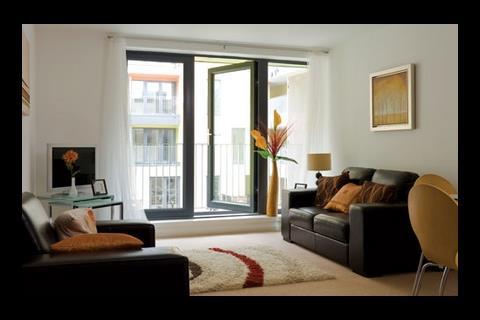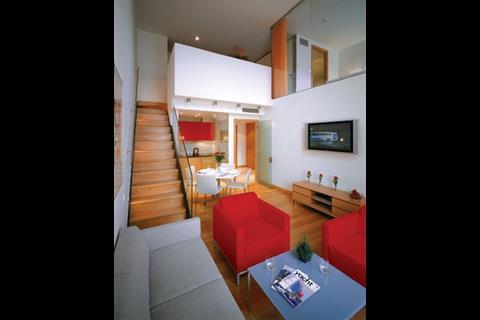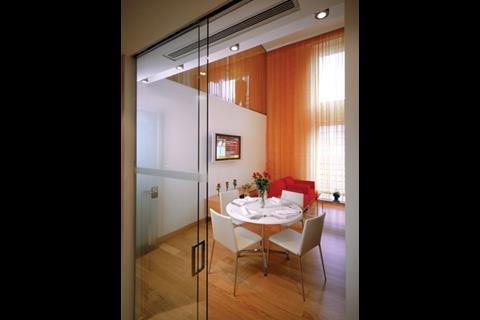Housing scheme interiors have to be affordable, durable and, most importantly, ŌĆśwhat the market wantsŌĆÖ. Eoin Keating considers the challenges architects face
All housing schemes are multiple repetitions of a limited number of basic dwelling types. However, they are also collections of unique interiors, dressed according to the tastes of their individual occupiers. The uniform products are the canvases upon which a wide range of personalities will be expressed, so it is therefore unsurprising that the neutrality (or blandness) of their interior finishes is interrupted only in the stage-set show homes.
Affordable housing and private schemes alike are finished neutrally but for different reasons. Private housing must display a tasteful simplicity that works with any furniture scheme and provide kitchens and bathrooms just like competitorsŌĆÖ houses. Hence white walls, if itŌĆÖs modern, or ŌĆ£taupeŌĆØ if itŌĆÖs not. Finishing in affordable housing is often determined by the maintenance department. The test is ŌĆ£Can I get it at Wickes?ŌĆØ. Hence magnolia.
It is interesting to find that neither white nor magnolia tends to be found in the finishes and materials for volume housebuilders or registered social landlords (RSLs). Most housebuilders have their own catalogue of finishes sourced through supply chains and selected by their marketing departments and RSLs face limited choice through the design and build process.
There is no doubt that this system works, but in a weak market, anything that distinguishes a scheme positively from its competitors could be a significant help in making sales.
That said, the opportunities for differentiation in terms of materials and finishes in mass housing are quite narrow. Walls are either painted or tiled. Floors can be carpeted, tiled, timber or sheet coverings. Using colour is a cheap and effective way of creating distinction but it is surprising just how difficult it can be to persuade this conservative sector to stray from off-white.
Choices of finshes are driven by common considerations: capital cost and durability. Cost applies to all finishes but durability is not a constant concern. For example, and depending on the market at which itŌĆÖs pitched, flooring in private housing is often considered disposable because, regardless of quality, there is an often justified perception that new owners will rip out and replace floor finishes as soon as they move in. Nevertheless, the quality of the original must match the quality expected of the value of the dwelling. Thus, the higher the sale value, the newer and better the wood flooring being fed into skips.
Perception of ŌĆ£what the market wantsŌĆØ underlies the natural conservatism of volume housing, which was once conveyed to us by a client who said: ŌĆ£We donŌĆÖt mind innovation, so long as itŌĆÖs tried and testedŌĆØ.
It is right to listen to customers but it can result in compromise that serves neither buyer nor seller. We are told that buyers want wood veneers on internal doors, wardrobes and kitchen units and that worktops and vanity tops should be stone. So thatŌĆÖs what they get. Except that the veneers are, and look, cheap and the countertops are stone-effect formica. However, if the doors were simply painted you might afford a real stone worktop that would actually convey the sense of quality being looked for.
Limited options and limited budgets are challenging. At Jestico + Whiles, we try to offer our housing clients alternatives to their habitual choices. For example, we have just completed a project where the common corridors and walkways are finished in a non-slip coating that was designed for waterproofing car park decks.
However, the importance of interior finishes in housing rests not so much with selecting materials and colours as in the backgrounds to which they are applied. Plasterboard. Simple. Yes, but what is important is the setting out and alignment of wall and ceiling surfaces. No matter how well painted they are, the overall effect will be marred by the haphazard boxings, bulkheads and downstands that could have been avoided with a little forethought (or even reading the drawings). Likewise, ceramic wall tiling should be a simple proposition but it is bewildering how often that tiling is badly set out.
Finishing is, as ever, all about preparation. Proper planning and supervision from the first trades onwards are essential. Then keep the lines clean, set out neatly and even the simplest finishes will exude quality.
Postscript
Eoin Keating is an associate director with architect Jestico + Whiles






























No comments yet